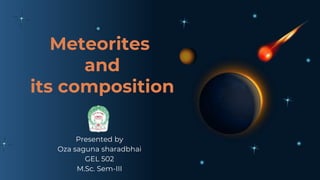
Meteorites: Composition and Origins
- 1. Meteorites and its composition Presented by Oza saguna sharadbhai GEL 502 M.Sc. Sem-III
- 2. Table of contents 01 04 02 05 03 About Types Origin and Composition Conlusion References
- 3. About 01
- 4. What is Meteor and meteorites? A meteorite is a solid piece of debris from an object, such as a comet, asteroid, or meteoroid, that originates in outer space and survives its passage through the atmosphere to reach the surface of a planet or moon. A meteor is small body of matter from outer space that enters the earth's atmosphere, becoming incandescent as a result of friction and appearing as a streak of light.
- 5. Differences Actual fragment of a meteoroid that has landed on the Earth's surface. The visible phenomenon of a small object burning up in the Earth's atmosphere. Meteor Meteorite
- 6. Meteorites A meteorite is a solid object that originates in outer space, survives its passage through Earth's atmosphere, and lands on the surface of the Earth. It is essentially a fragment or piece of material from a larger parent body, such as an asteroid, the Moon, or Mars, that has been ejected into space and then falls to Earth. ● Meteorites are typically composed of rock- forming minerals, metals, and sometimes organic compounds. ● They can vary in size, ranging from tiny grains to large boulders.
- 7. Types 02
- 8. The main types of meteorites Primarily composed of iron and nickel Mostly composed of silicate minerals A combination of silicate minerals and nickel-iron alloy Iron Stone Stony-irons
- 10. These meteorites are primarily composed of iron and nickel, and they are thought to originate from the cores of asteroids. Asteroids are rocky bodies that can be found in the asteroid belt, a region located between the orbits of Mars and Jupiter. Occasionally, collisions between asteroids can break off fragments, and some of these fragments eventually find their way to Earth. Some iron meteorites contain Widmanstätten patterns, which are unique crystalline structure that formed as the meteorite cooled. Iron meteorite found in 1864 in the Sahara, weighing about 500 kg
- 11. Segment of the Toluca meteorite, about 10 cm wide
- 12. Stony meteorites, also known as stone meteorites or simply "stones," are one of the three main categories of meteorites, alongside iron and stony-iron meteorites. They are composed mostly of silicate minerals, similar to the rocks found on Earth. Stony meteorites are further divided into two main subcategories. Stony meteorite
- 13. Chondrites are the most common type of stony meteorites. They contain small, round structures called chondrules, which are believed to have formed in the early solar system, possibly due to shockwaves from nearby supernovae. Chondrites provide valuable information about the early stages of our solar system's formation and the materials present during that time. Chondrites
- 14. Achondrites are stony meteorites that do not contain chondrules. Unlike chondrites, they are believed to originate from larger planetary bodies like asteroids, planets, or moons. Achondrites may have experienced processes such as volcanism or differentiation, which means they underwent geological processes similar to those on Earth. Achondrites
- 15. Stony-iron meteorites, as the name suggests, are a type of meteorite that contains a combination of both stony material (silicate minerals) and iron-nickel metal. Stony-iron meteorites are believed to originate from the boundary region between a planet's core and mantle. They represent a unique and relatively rare class of meteorites, making up about 1% of all known meteorite falls. Stony-iron meteorites are further divided into two subcategories based on their composition and structure. Stony-Iron Meteorite
- 16. Pallasites are the most well-known type of stony-iron meteorites. They are characterized by a beautiful and striking intergrowth of olivine crystals (a greenish-yellow gem-quality mineral) and a metallic matrix. Pallasites are thought to originate from the mantle- core boundary of differentiated asteroids. The olivine crystals embedded in the metallic matrix make them visually stunning and highly sought after by collectors and researchers alike. Pallasites
- 17. Mesosiderites are another type of stony-iron meteorite, but they are much rarer than pallasites. They have a more heterogeneous appearance, with metal veins and silicate clasts mixed together. Mesosiderites are believed to be the result of violent collisions between different parent bodies in the early solar system, where the mantles and cores of these bodies were mixed together in the impact. Mesosiderites
- 18. 04 Conclusion
- 19. Meteorites are fascinating and valuable objects that provide important insights into the history and composition of our solar system. Meteorites have contributed significantly to scientific understanding, helping researchers learn about the processes that occurred during the early stages of our solar system's formation. By studying meteorites, scientists gain insights into planetary differentiation, the conditions in the early solar system, and the history of impacts and collisions.
- 20. 05 Resources
- 21. Alternative resources • https://chat.openai.com/ • https://en.wikipedia.org/wiki/Widmanst%C3%A4tten_ pattern#:~:text= Widmanst%C3%A4tten%20patterns%2C%20also%20known%20as,ban ds%20or%20ribbons%20called%20lamellae
- 22. Thank you!! Do you have any questions ?
Editor's Notes
- They have various origins, and there are three primary types of meteorites based on their sources: iron meteorites, stony meteorites, and stony-iron meteorites.
- Widmanstätten patterns, also known as Thomson structures, are figures of long nickel–iron crystals, found in the octahedrite iron meteorites and some pallasites. They consist of a fine interleaving of kamacite and taenite bands or ribbons called lamellae. Commonly, in gaps between the lamellae, a fine-grained mixture of kamacite and taenite called plessite can be found. Widmanstätten patterns describe features in modern steels,[1] titanium, and zirconium alloys.
- showing chondrules and metal flakes
- Note the shiny black fusion crust with flow lines. The chip at lower right allows one to see the light-gray interior. The orange staining at top is a result of weathering, as these stones were not recovered until many years after they fell.